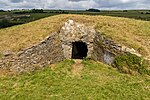Shoscombe and Single Hill Halt railway station
Beeching closures in EnglandDisused railway stations in SomersetFormer Somerset and Dorset Joint Railway stationsPages with no open date in Infobox stationRailway stations in Great Britain closed in 1966 ... and 4 more
Railway stations in Great Britain opened in 1929Somerset building and structure stubsSouth West England railway station stubsUse British English from July 2012

Shoscombe & Single Hill Halt was a small railway station on the Somerset and Dorset Joint Railway serving small villages between Wellow and Radstock, about seven miles south of Bath. The station was the last to open on the Somerset and Dorset main line, with services beginning on 23 September 1929. It closed with the rest of the line on 7 March 1966 under the Beeching Axe.The station, sited in the hamlet of Single Hill, consisted of two bare concrete platforms, with ornate oil lamps but without buildings. A small building containing a booking office and a waiting room was provided on the footpath leading to the station.
Excerpt from the Wikipedia article Shoscombe and Single Hill Halt railway station (License: CC BY-SA 3.0, Authors, Images).Shoscombe and Single Hill Halt railway station
Tenantsfield Lane,
Geographical coordinates (GPS) Address Nearby Places Show on map
Geographical coordinates (GPS)
| Latitude | Longitude |
|---|---|
| N 51.3 ° | E -2.4 ° |
Address
Tenantsfield Lane
BA3 5YD , Hemington
England, United Kingdom
Open on Google Maps








